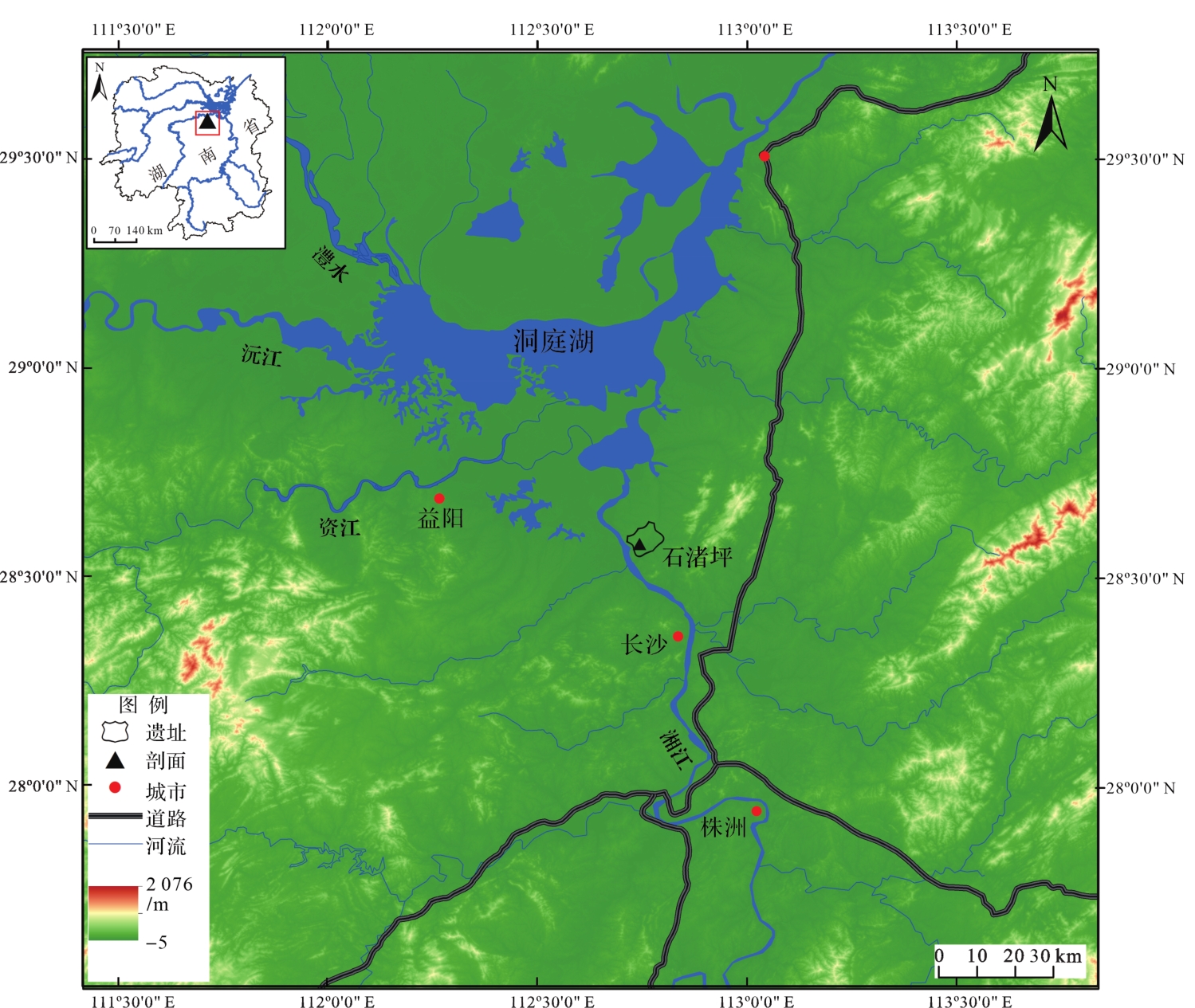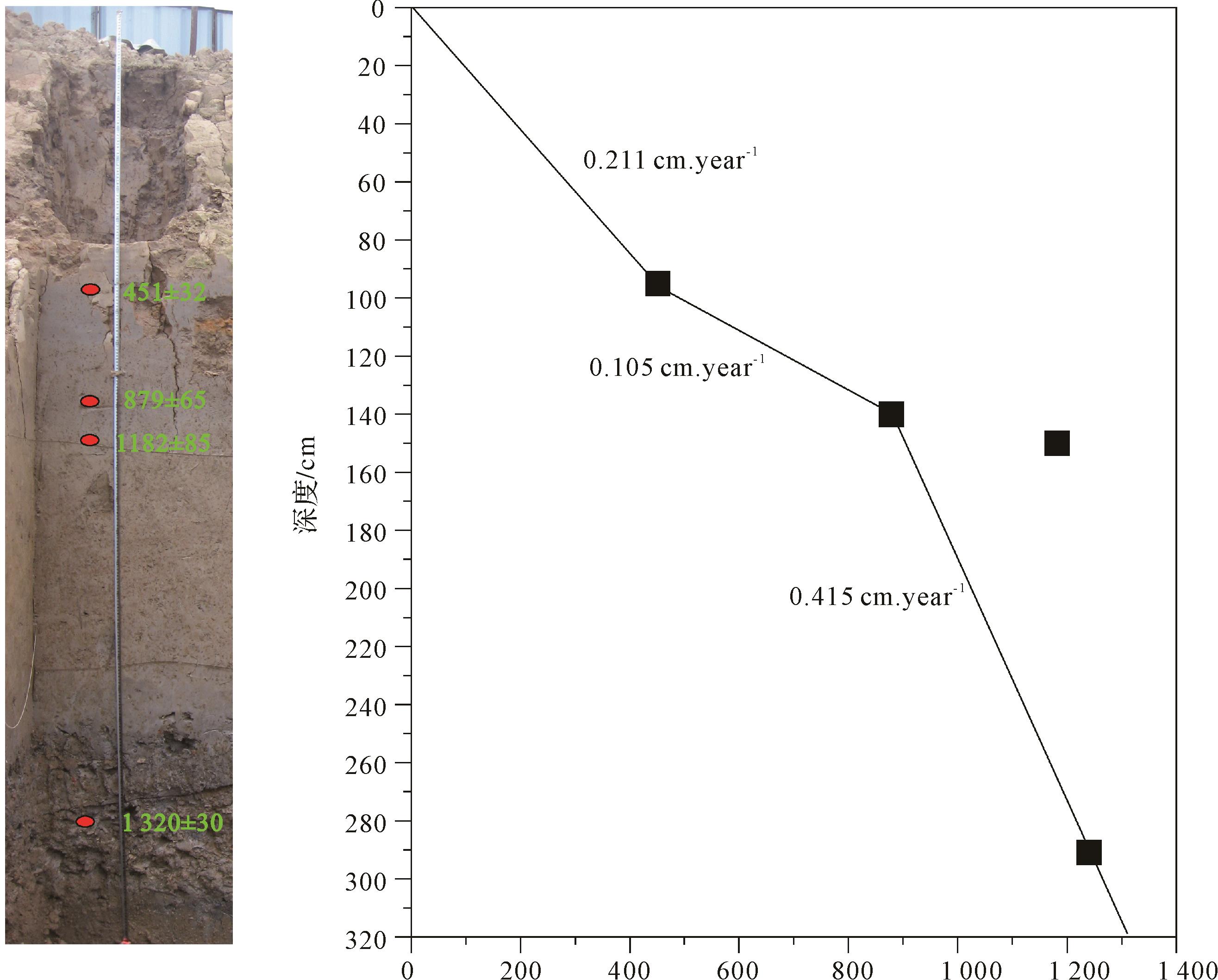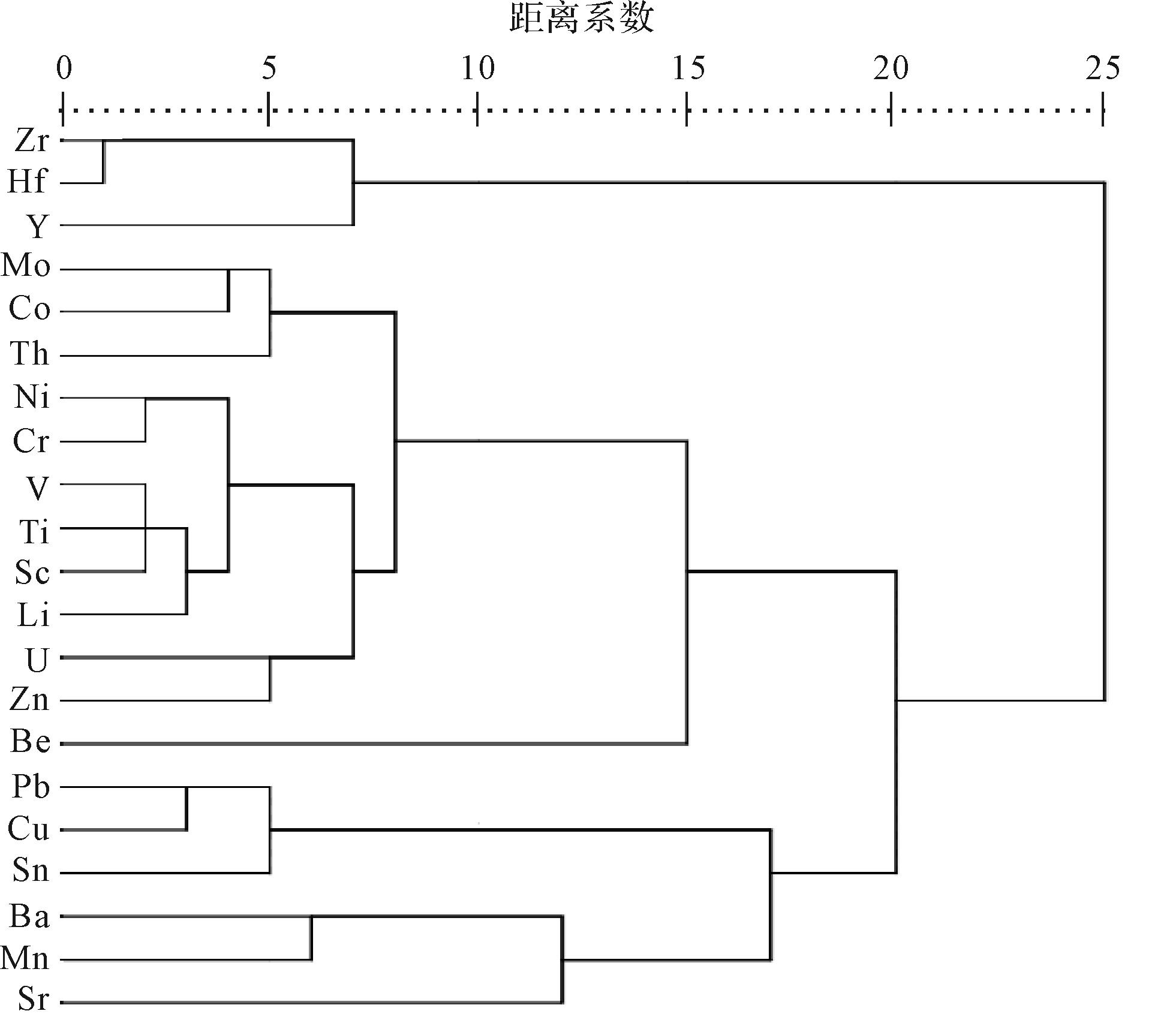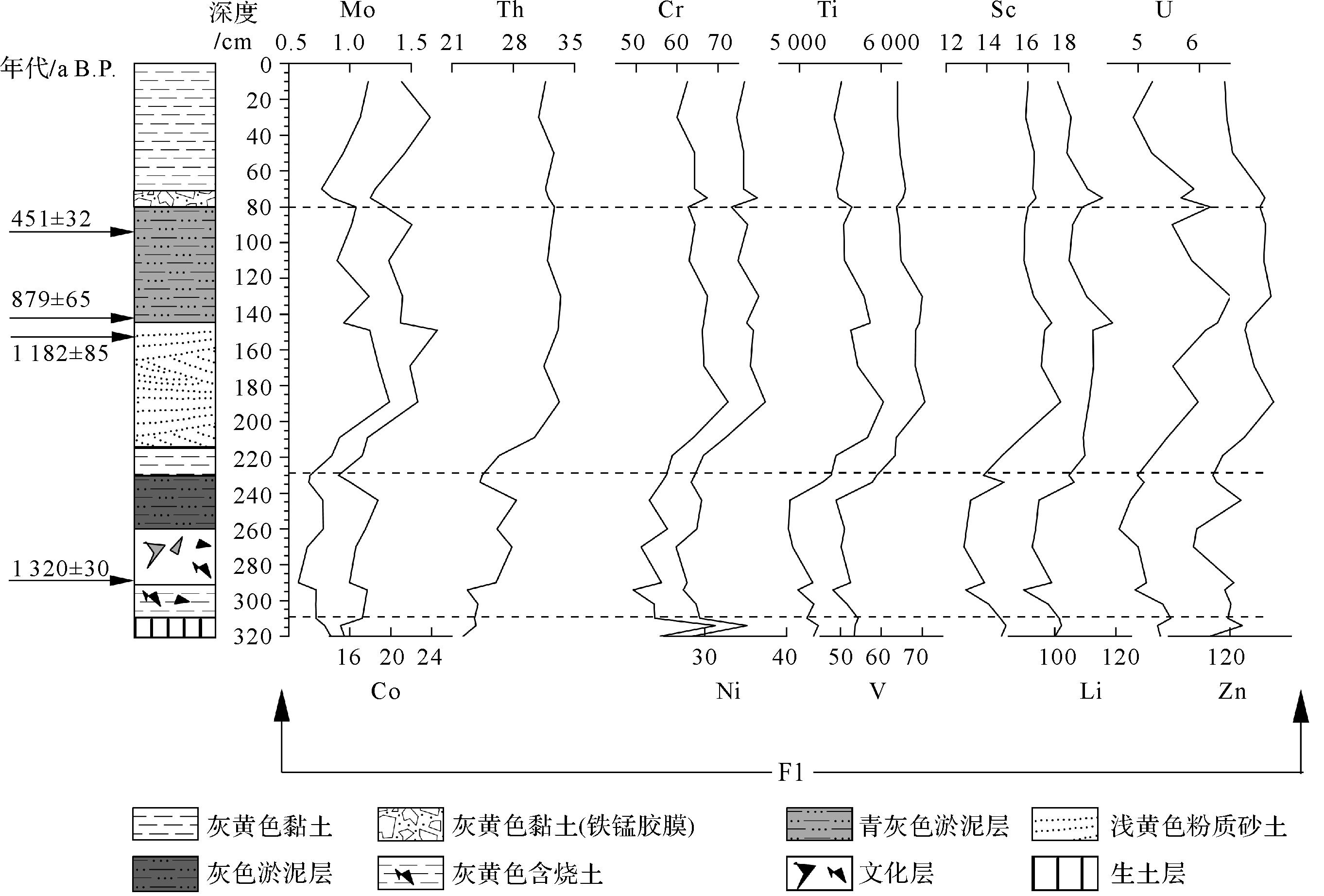HTML
-
沉积物地球化学的元素含量、元素比值、迁移富集特征、同位素含量等与沉积环境和物质来源密切相关[1⁃2]。因此,前人使用地球化学方法在沉积环境重建[3]、古气候极端事件[4]、沉积物风化强度[5]、物质来源[6]等多方面进行了大量研究,并取得了一些研究成果。如刘平贵等[7]通过分析银川盆地Y1孔地球化学元素含量及其分布规律,还原了该地层由还原到氧化的地球化学环境,由深水到浅水的水环境以及由湖沼相到河流相的沉积相。陶树等[8]测量了川东南—黔中及其周边地区震旦—志留纪地层的主量元素及微量元素含量,利用元素比值分析得出其沉积环境主要为半深海—深海及浅海滞流环境。Wang et al.[9]研究了内蒙古兴蒙地区元素比值的特征参数,指出研究区中、晚二叠世之交的主要沉积环境为海相和强还原环境。张文翔等[10]用柴达木贝壳堤剖面沉积物常量元素和微量元素含量及其元素比值,重建了43.5~22.4 ka B.P.高湖水位期间的古气候和水位波动历史。周笃珺等[11]利用青海湖地区全新世黄土剖面的元素组分、氧和碳同位素等指标,探讨了青海湖湖区温湿—高温—冷干—暖湿—暖干—冷干的气候环境演变过程。Kraft[12]对华南南雄盆地白垩系和第三系碎屑沉积岩进行了分析,通过晚白垩世CaCO3含量、TOC值、Rb/Ti、Cs/Ti比值等,揭示了华南地区长期的极端干旱气候。Piper et al.[13]通过对密西西比河水系的河床沉积物和悬沙的地球化学研究,得出沉积物微量元素富集可能与人类活动有关。
湘江是湖南省最大的河流,属于长江流域洞庭湖水系。前人对于湘江流域沉积物开展了地球化学相关研究,主要关注湘江流域沉积物重金属的地球化学特征[14⁃16]、污染性评价和来源分析[17⁃19]。长沙铜官窑遗址剖面正处于湘江流域中下游地区,铜官窑是外销窑,盛行于中晚唐而衰于五代[20]。长沙窑地区的沉积环境及物质来源的研究是解读长沙窑兴衰过程与环境变化关系的前提。因此,本文拟以长沙窑遗址石渚坪(SZP)剖面沉积物为研究对象,对其沉积物进行地球化学元素分析,揭示其元素地球化学特征,探讨其沉积环境。
-
SZP剖面(28°25′0.92″ N,112°49′35.7″ E)位于长沙市望城区丁字镇铜官窑考古遗址(图1),海拔约25 m,处于湘江流域下游地区,洞庭湖平原以南。铜官窑遗址在石渚湖北岸,西南滨湘江,位于觉华山山脚下。地貌呈现为丘陵向平原过渡,高出现代河堤1~2 m。铜官窑遗址距离湘江约1 km,位于湘江的二级阶地,2011年湖南省文物考古研究所考古发掘时出露该遗址剖面。研究区域为亚热带季风气候,四季温差明显,雨热同期。年均气温为17.8 ℃,年降水量介于1 250~1 750 mm[21]。湘江是洞庭湖水系中流域面积最大的河流,水源至濠河口干流全长856 km,总流域面积94 600 km2[22]。在地质构造上,湘江源头在南岭构造带,向北汇入扬子板块的洞庭湖。流域上游以石灰岩为主,其中南部地区广泛分布石灰岩和砂岩,中下游区域则以砂岩、页岩、砾岩及花岗岩为主[23]。地貌特点为低山高丘与盆地相间,丘陵低缓。植被主要是马尾松稀疏草丛和油茶林,部分沟谷中有常绿阔叶林。土壤以红壤和紫色土为主,水土流失比较严重[24]。
-
SZP剖面为含文化层剖面,地层界线分明,清晰可见(表1)。该剖面在铜官窑遗址范围内,是专门开挖的平行剖面,距离湘江约50 m,位于河流二级阶地且靠近丘陵。剖面厚度为320 cm,未见底。以每间隔2 cm或10 cm不等距取样,共采集99份样品,样品编号为SZP001~SZP099。文化层为260~290 cm,出土大量的瓷块和瓷片,时间约在唐代中晚期。
地层深度/cm 地层特征 0~70 灰黄色黏土,含黑色斑块与胶膜、红色碎块、青灰色小砾石(0.5~1 cm)以及大量虫孔。在5~10 cm处发现灰色陶片 70~80 灰黄色黏土,沿裂隙发育大量红色Fe、Mn胶膜 80~145 青灰色淤泥,沿裂隙面发育红黄色胶膜,含虫孔 145~215 浅黄色,粉砂质黏土,无层理 215~230 灰黄色黏土 230~260 灰色淤泥层,含大量陶片 260~290 唐代中晚期文化层,含大量的陶块和陶片、红烧土 290~310 灰黄色,含少量烧土,含大量的碳粒和碳片,厚度约5~10 cm 310以下 浅黄色生土 -
所有样品在实验室进行自然风干,取出5 g样品使用玛瑙研钵进行研磨,过200目筛。然后实验前,对磨好的样品在烘箱内烘干,烘干后称取25 mg样品置于自制高压密闭溶样装置中。加入0.5 mL浓HF后加热蒸干,去除样品中的部分Si。再加入1 mL浓HF和0.5 mL浓HNO3于190 ℃溶解,蒸干至湿盐状,再加入1 mL HNO3蒸干至湿盐状,去除过量HF。蒸干后以5 mL的30%(v/v) HNO3在140 ℃时提取残渣,冷却后加入1 mL的500 ng/mL的RH内标溶液稀释到50 mL用以减轻基体效应及仪器漂移带来的影响。测得Li、Sc、Ti、V、Cr、U、Be、Pb等共33种微量元素,分析结果与标样测定结果进行比较,误差均小于±10%。微量元素的含量用高分辨率电感耦合等离子体质谱仪(HR-ICPMS)进行测定,实验在南京大学地球科学系内生金属矿床成矿机制研究国家重点实验室完成[25]。分别在94~96 cm、139~141 cm和149~151 cm以及290~292 cm采集了3个OSL和1个AMS14C样品进行年代测定(表2),实验在北京大学AMS14C/OSL实验室(用CALIB 7.01校准)完成。除此以外,在剖面260~290 cm间的文化层中出土的陶器碎片被确定为中晚唐的器物。利用Tan et al.[26]基于测年结果和瓷器类型学建立的相对年代学框架,建立了一个年代—深度模型(图2)。
样品编号 深度/cm 校正年代/a B.P. AB120171 94~96 451±32 AB120172 139~141 879±65 AB120173 149~151 1 182±85 BA120171(AMS14C) 290~292 1 320±30 
Figure 2. Age vs. depth plot for SZP profile[26]
2.1. 材料来源
2.2. 测试方法
-
剖面选择4个样品完成年代测试,其中AMS14C(用Calib7.01校准)1个和OSL年代3个。OSL年代测定使用Riso-TL/OSL-DA15测年系统,在SZP剖面260~290 cm间的文化层中出土的大量瓷器碎片被确定为中晚唐的器物。建立的剖面年代序列如表2和图2。
-
SZP剖面地球化学元素(Ti、Mn、Li、Be、Sc、V、Cr、Co、Ni、Cu、Zn、Rb、Sr、Y、Zr、Mo、Sn、Cs、Ba、Hf、Pb、Th、U)含量变化如表3。Ti含量最高,平均值达到5 405.8 μg/g,其次是Mn,平均值为988.8 μg/g。元素中含量平均值较高的有Li、Mn、Zr、Ba、Rb、Zn,均在100 μg/g以上。含量较低的是Be、Mo、Hf、Ta、W、Bi、U,平均值皆在10 μg/g以下。最低的是Mo,平均值为0.9 μg/g。剖面含量均值由大到小为:Ti>Mn>Ba>Zr>Rb>Zn>Li>Cr>V>Pb>Sr>Cu>Y>Ni>Th>Cs>Co>Sc>Sn>Hf>U>Be>Mo。
深度 Li Be Sc Ti V Cr Mn Co Ni Cu Zn Rb Sr Y Zr Mo Sn Cs Ba Hf Pb Th U 80 cm以上 最小 100.9 3.1 15.9 5 421.7 63.7 60.0 620.0 18.0 33.3 35.6 117.5 165.2 47.9 32.0 209.3 0.8 7.1 19.1 484.2 6.6 49.9 30.9 4.9 最大 115.7 4.0 16.4 5 638.9 66.0 67.3 2 493.1 23.9 36.5 38.7 137.1 180.4 50.0 34.3 271.9 1.2 10.9 22.9 646.1 8.2 74.4 32.7 6.2 均值 107.6 3.5 16.2 5 506.9 64.6 63.6 1 146.1 20.4 34.7 37.0 127.3 174.7 49.0 33.2 235.3 1.0 9.2 20.1 526.7 7.3 56.9 31.9 5.5 80~230 cm 最小 104.6 3.3 13.8 5 386.1 58.9 57.4 503.2 14.9 28.8 34.9 111.8 171.3 47.5 27.8 199.6 0.7 7.6 18.1 502.1 6.0 53.1 24.5 5.0 最大 118.9 4.5 17.6 6 023.6 70.7 72.5 1 578.8 24.5 37.4 44.2 141.4 186.6 53.5 37.7 260.4 1.3 15.3 22.3 546.8 7.9 66.9 33.4 6.5 均值 110.0 3.8 16.0 5 676.8 66.2 64.7 876.3 20.3 34.1 38.4 129.9 177.1 49.8 32.7 228.3 1.0 11.3 19.3 519.3 7.1 57.9 31.0 5.8 230~310 cm 最小 89.9 3.3 12.9 4 864.8 48.1 49.3 800.9 16.0 26.5 30.4 102.2 155.4 45.6 30.5 220.4 0.6 7.0 21.2 506.4 6.5 38.8 22.7 4.7 最大 106.4 4.0 14.8 5 279.2 57.8 57.6 1 997.9 18.8 29.6 97.3 125.4 183.4 55.4 37.1 317.3 0.8 20.2 27.1 631.3 9.3 129.7 28.4 5.5 均值 97.0 3.6 13.7 5 042.7 51.8 54.1 1 093.2 17.2 28.4 41.4 115.5 173.1 50.1 34.2 275.0 0.7 9.9 24.7 543.1 8.2 58.3 25.4 5.1 310~320 cm 最小 100.2 3.5 14.7 5 168.6 53.4 55.8 628.9 15.1 28.4 26.7 110.1 178.8 48.8 33.0 241.2 0.8 6.9 25.0 509.3 7.3 37.3 22.3 5.3 最大 102.2 3.6 14.9 5 230.8 53.6 69.4 695.3 15.4 35.1 29.0 126.0 182.7 49.7 34.2 248.3 0.8 7.5 25.1 530.1 7.5 40.4 23.7 5.4 均值 101.2 3.6 14.8 5 199.7 53.5 62.6 662.1 15.3 31.8 27.8 118.1 180.7 49.2 33.6 244.7 0.8 7.2 25.0 519.7 7.4 38.9 23.0 5.3 全剖面 最小 89.9 3.3 12.9 4 864.8 48.1 49.3 503.2 14.9 26.5 26.7 102.2 155.4 45.6 27.8 199.6 0.6 6.9 18.1 502.1 6.0 37.3 22.3 4.7 最大 118.9 4.5 17.6 6 023.6 70.7 72.5 1 997.9 24.5 37.4 97.3 141.4 186.6 55.4 37.7 317.3 1.3 20.2 27.1 631.3 9.3 129.7 33.4 6.5 均值 104.0 3.7 14.9 5 371.0 58.9 60.4 991.6 18.4 31.5 40.6 121.9 175.8 50.0 33.3 249.7 0.9 10.7 22.2 532.6 7.6 58.2 27.6 5.4 湖南土壤背景值[27] 1.06 11 136 68 441 14 32 27 95 139 57 27 260 347 27 17 4.2 湘江沉积物背景值[28] 46.7 2.83 4 487 92.1 66.8 855 13.6 29.9 30 87.4 48.6 27 347 1.28 8.45 354 39.7 17.8 4.21 上陆壳UCC[29] 20 3 13.6 4 100 107 83 600 17 44 25 71 112 350 22 190 1.5 5.5 4.6 550 5.8 17 10.7 2.8 元素含量随着深度的变化而变化,可能与当时的沉积环境和物质来源相关。元素Sc、V、Ni、Th、Mo、Ti、Cr、Co、Li、U、Zn变化趋势一致,在80~230 cm的地层为高值区,在230 cm以下的地层为低值区。Pb、Cu、Sn、Hf、Zr、Y、Ba、Mn、Sr与上述元素呈相反的变化趋势,230 cm以下的地层为它们的高值区。Pb、Cu在230 cm以上的地层波动不大,在230~310 cm出现最大值,Sn、Hf、Zr、Y、Ba、Mn、Sr在80~230 cm之间出现小幅升高。在80 cm上出现峰值的有Ba、Mn、Mo、Co。
-
微量元素之间相关性高,表明它们的来源可能一致,若相关性较差,来源可能就不同[30]。Ti与微量元素Sc、Li、V、Cr显著相关,相关系数均在0.8以上(置信度为99%)(表4)。Sc与Li、V、Cr、Ni;V与Li、Sr、Cr、Ni;Ni与Mo、Th;Cr与V、Ni;Co与Mo、Th在0.01水平上高度正相关,相关系数在0.8以上。这说明它们可能具有相同的物质来源。Pb与Cu(0.877)、Sn(0.759)呈正相关,与Rb(-0.25)、Cs(-0.456)负相关。Cu与Sn(0.794)正相关,与Sr(0.454)呈弱相关。Hf与Zr(0.983)、Y(0.736)显著相关,Zr与Y(0.668)相关性较高。Ba与Mn(0.744)相关性显著,与Sr(0.594)相关性较高,与Cu(0.444)弱相关。Mn与Sr(0.365)弱相关。
Li Be Sc Ti V Cr Mn Co Cu Ni Zn Rb Sr Y Zr Mo Sn U Th Pb Hf Ba Li 1.000 Be 0.370 1.000 Sc 0.875 0.325 1.000 Ti 0.863 0.370 0.910 1.000 V 0.898 0.274 0.933 0.937 1.000 Cr 0.799 0.443 0.877 0.830 0.838 1.000 Mn -0.165 -0.209 -0.004 -0.155 -0.084 -0.158 1.000 Co 0.435 0.122 0.681 0.590 0.681 0.522 0.498 1.000 Cu 0.064 0.122 0.002 0.005 0.062 0.039 0.377 0.275 1.000 Ni 0.737 0.326 0.900 0.794 0.846 0.936 0.039 0.713 0.135 1.000 Zn 0.648 0.423 0.731 0.704 0.667 0.722 -0.139 0.527 0.282 0.791 1.000 Rb 0.480 0.314 0.445 0.399 0.335 0.431 -0.264 -0.010 -0.581 0.305 0.300 1.000 Sr 0.014 0.379 0.062 0.062 -0.052 0.036 0.365 0.158 0.454 0.149 0.406 0.028 1.000 Y -0.263 0.387 0.048 -0.123 -0.132 0.090 0.358 0.327 -0.025 0.156 0.031 0.079 0.215 1.000 Zr -0.692 -0.014 -0.518 -0.540 -0.605 -0.433 0.329 -0.114 -0.024 -0.437 -0.464 -0.257 0.026 0.668 1.000 Mo 0.558 0.281 0.781 0.746 0.766 0.718 0.201 0.840 0.152 0.814 0.566 0.062 0.166 0.240 -0.232 1.000 Sn 0.390 0.370 0.255 0.332 0.323 0.297 0.019 0.209 0.794 0.276 0.459 -0.250 0.287 -0.199 -0.337 0.208 1.000 U 0.741 0.414 0.766 0.750 0.720 0.670 -0.223 0.451 -0.040 0.679 0.769 0.559 0.179 0.059 -0.458 0.548 0.240 1.000 Th 0.630 0.244 0.753 0.726 0.814 0.706 0.148 0.812 0.339 0.803 0.661 0.014 -0.003 0.171 -0.247 0.731 0.367 0.602 1.000 Pb 0.182 0.139 0.096 0.135 0.192 0.115 0.167 0.276 0.877 0.173 0.313 -0.593 0.197 -0.122 -0.186 0.194 0.759 0.033 0.442 1.000 Hf -0.615 0.034 -0.419 -0.462 -0.519 -0.346 0.329 -0.011 -0.013 -0.329 -0.344 -0.202 0.041 0.736 0.983 -0.151 -0.329 -0.328 -0.118 -0.162 1.000 Ba -0.194 -0.003 -0.154 -0.259 -0.222 -0.199 0.744 0.252 0.444 -0.039 -0.017 -0.138 0.594 0.274 0.149 0.033 0.157 -0.204 -0.044 0.247 0.151 1.000 Cs -0.633 -0.275 -0.625 -0.696 -0.774 -0.674 0.189 -0.532 -0.315 -0.686 -0.530 0.067 0.145 0.217 0.524 -0.589 -0.516 -0.448 -0.771 -0.456 0.458 0.285 -
因子分析前的KMO(Kaiser-Meyer-Olkin检验)=0.534,Bartlett球度检验结果显示(DF=253,Sig.<0.001),说明样品数据适用于因子分析。通过主成分分析,可分为五个主成分,第一主成分的特征值为10.053,方差贡献为43.710%;第二主成分的特征值为3.912,贡献了17.007%;第三主成分特征值为3.016,贡献了13.112%;第四主成分特征值为1.802,贡献了7.836%;第五主成分的特征值为1.520,贡献了6.610%。这五个主成分的总累积解释方差为88.274%,大于85%,说明这五个主成分可反映所有数据的大部分信息(表5)。以累积方差贡献88.274%为准,可以提取五个主成因子:F1包括Sc、V、Ni、Th、Mo、Ti、Cr、Co、Li、U、Zn;F2包括Pb、Cu、Sn;F3包括Hf、Zr、Y;F4包括Ba、Mn、Sr;F5包括Be。
元素 成分 成分1 成分2 成分3 成分4 成分5 Sc 0.936 -0.095 -0.191 0.009 0.157 V 0.929 0.033 -0.290 -0.110 0.047 Ni 0.927 0.030 -0.072 0.062 0.157 Th 0.889 0.319 0.109 -0.033 -0.040 Mo 0.883 0.084 0.115 0.139 -0.030 Ti 0.873 -0.016 -0.264 -0.124 0.205 Cr 0.862 -0.021 -0.105 -0.135 0.289 Co 0.837 0.158 0.208 0.340 -0.202 Li 0.765 -0.009 -0.466 -0.086 0.259 Cs -0.716 -0.441 0.221 0.327 0.017 U 0.709 -0.146 -0.182 -0.054 0.453 Zn 0.690 0.168 -0.191 0.095 0.485 Pb 0.157 0.927 -0.094 0.097 0.028 Cu 0.065 0.904 -0.007 0.348 0.095 Sn 0.216 0.786 -0.262 0.062 0.348 Rb 0.287 -0.740 -0.191 -0.011 0.461 Hf -0.260 -0.045 0.931 0.071 -0.031 Zr -0.374 -0.039 0.891 0.066 -0.070 Y 0.160 -0.131 0.874 0.227 0.220 Ba -0.113 0.174 0.087 0.909 0.011 Mn 0.098 0.131 0.303 0.807 -0.362 Sr 0.000 0.168 0.011 0.712 0.547 Be 0.272 0.119 0.213 -0.080 0.820 特征值 10.053 3.912 3.016 1.802 1.520 变量解释/% 43.710 17.007 13.112 7.836 6.610 累积/% 43.710 60.717 73.829 81.664 88.274 -
聚类分析能够直接观察各元素之间的远疏距离,距离系数的长短代表元素间来源的相关性程度,最先连接且距离最短的元素之间相关性高且来源相似[31]。对SZP剖面的地球化学元素进行R型聚类分析(图3),当距离系数选为15时,可以分成五组,聚类分析结果与主成分分析结果完全一致。
3.1. 剖面年代序列
3.2. 石渚坪剖面地球化学元素分布
3.3. 多变量分析
3.3.1. 元素相关性分析
3.3.2. 主成分分析
3.3.3. 聚类分析
-
根据多变量分析结果,可以将元素分为5类(F1~F5),F1:Sc、V、Ni、Th、Mo、Ti、Cr、Co、Li、U、Zn;F2:Pb、Cu、Sn;F3:Hf、Zr、Y;F4:Ba、Mn、Sr;F5:Be。
F1解释了方差的43.710%,所占比重最大,说明在石渚坪剖面的沉积物中F1对其他变量的影响占据主导地位。Sc、V、Ni、Ti、Cr、Co、Li、Zn等元素在风化、侵蚀搬运和沉积的表生环境下较为稳定[32]。其中,铁族元素居多,包括Ti、Cr、Co、V、Ni,Ti、Cr、V,同时也为造岩元素,说明F1因子以陆源碎屑为主。Ti是亲碎屑元素,Ti离子在水溶液中迁移微弱,但Ti能在风化作用下富集,尤其是在玄武岩和一些其他基性岩风化形成的土壤中Ti含量明显居多[33]。Ti与微量元素Sc、Li、V、Cr显著的相关性说明它们的来源相似。Zn作为亲铜元素被分在F1因子中也许是因为其原生矿物较难风化或次生矿物稳定难溶,而后吸附于黏土矿物,在风化过程中得以保留[34]。在湘江流域广泛分布的古生代碳酸盐岩和印支—燕山期花岗岩体,这些岩石均是在地表条件下易于风化分解的地质体,其中,上游主要是泥盆系砂、页岩和泥盆系—石炭系的石灰岩,中下游区域中新生代的紫色砂岩与花岗岩[24]。但是,铁族元素在基性岩与超基性岩中分布广泛,在石灰土及石灰岩地区土壤中含量最高[28]。因此,可以推断F1主要来源于上游地区的石灰岩。
F2包括Pb、Cu、Sn,贡献了17.007%。3个元素皆是亲硫元素,易形成硫化物。湖南省内的侵入岩发育,与铜铅锌矿有关的主要是印支—燕山期花岗岩体[35],铜矿很少有单一铜矿,共伴生铜的矿床比重大,铜常和铅、锌、锡、钴等形成多金属矿床[36]。F2可能来源于对湘江流域附近铜铅锡矿等有色金属矿的人为开采活动。
F3包括Hf、Zr、Y,贡献了13.112%。Hf与Zr的地球化学性质相似,矿物中Hf常与Zr伴生。在风化前期或风化成熟度较低的情况下,Zr和Hf往往呈弱相关。随着矿物风化增大,Zr和Hf显著相关,Zr和Hf会迁移,仅以锆石的形式保留下来[37]。锆石在火成岩中广泛存在,在花岗岩矿岩内属于副矿物[38]。因此,F3可能来源于中下游地区花岗岩风化侵蚀。
F4包括Ba、Mn、Sr,贡献了7.836%。Ba、Sr同属碱土金属元素,同时也是亲石元素。Ba在细粒陆源沉积岩如粉砂岩、泥岩中含量较高,Sr在泥岩、钙质泥岩和碳酸盐岩中含量较高[39]。在湖南地区,Ba在砂页岩中含量最高,在石灰岩发育的土壤中含量低[28]。所以F4可能与中下游地区的砂岩的风化剥蚀有关。但在SZP剖面中,Ba均值是湖南背景值均值的1.53倍,湘江沉积物均值的1.5倍,Mn均值是湖南背景值均值的4.53倍,湘江沉积物均值的2.34倍,远高于湘江沉积物和湖南土壤背景值。可以推断F4物源主要与锰矿物的人为开发有关。
F5包括Be。湖南地区大部分有色金属矿床与中酸性花岗岩有成因联系,燕山期不同成因类型的花岗岩成矿专属性不同,花岗岩会形成Ta-Be、Sn、Mo、Bi-Cu、Pb、Zn-U等矿床系列[40]。SZP剖面中Be含量平均值是湖南背景值的4.27倍,是湘江沉积物的1.06倍,说明SZP剖面中Be富集可能与中下游地区花岗岩有色金属矿床的人为开采有关。
-
310 cm以下为生土层,此时生土多为末次冰期时的风尘堆积[41]。晚更新世冰期最盛时,长江中下游地区气候普遍寒冷且降水量减少,黄土高原堆积厚层的马兰黄土,在长江中下游地区的下蜀黄土开始堆积[42]。如江西定山砂山剖面的下层灰黄色土—淤泥沉积是末次冰期间冰阶晚期的区域降尘堆积[43],鄱阳湖地区的彭泽红光、小学剖面皆为黄土状土—中细砂堆积,分别对应末次冰期早、中期及末次冰期中、后期的堆积[44]。末次冰期期间,全球大范围气候寒冷干旱,海平面大幅降低,大陆架出露成陆[45]。海平面降低,河流下切侵蚀能力加强,河谷漫滩加深。此时强劲的冬季风吹蚀河谷漫滩,产生大量粉尘,河流台地开始形成堆积[46],SZP剖面的下部就是典型的下蜀黄土层,F1因子中的Cr、Ni、Ti、Zn出现峰值(图4),生土层的物源主要是上游的石灰石风化剥蚀。
230~310 cm,对应年代为1 288~1 094 a B.P.。沉积层下部颜色由灰黄色转为黑色,显示此时水位逐渐上升,石渚洼地开始积水形成石渚湖,其沉积物为黑色湖沼相淤泥沉积。此时,长沙窑先民利用此地进行制窑,在黑色淤泥层中发现烧土和大量的碳粒、碳片,这也表明约在盛唐开元年间,石渚制瓷业已经有所发展。根据考古发掘发现长沙窑纪年瓷中最早的记录正是记有“开元三年”字样的瓷碗[47]。此沉积层的上部为唐朝文化层,大量的瓷片和缸片表明当地制瓷业在唐朝中晚期的繁荣,现有的研究也可佐证长沙窑发展的繁荣期是在唐朝中晚期[20]。唐朝气候总体上趋于湿润,唐末30年更是多雨阶段,唐末集中的水灾记录也体现了湿润的气候[48],这些都充分表明了此时的高水位,石渚湖初步形成。Pb、Cu、Sn、Ba、Mn、Sr皆在文化层出现峰值(图5)。长沙窑瓷器以与当时主流不符的彩瓷闻名,制造原料多就地取材,其釉彩制作以磷灰石、方解石为熔剂,用Cu、Fe、Mn等矿物做釉彩着色剂[20]。方解石中含有Mn、Sr、Ba、Pb、Co、Fe、Zn、Mg等类质同象替代物,釉彩中的乳浊现象主要是因为含Cu矿物中含有部分SnO2[49]。在瓷器的制作过程中,各种矿物的开采和冶炼活动中产生的废料被沉入水中,随着水位的上升,窑址逐渐被洪水掩盖。可以看出此时物源主要是长沙铜官窑瓷器的煅烧过程中,各种金属矿物开采及冶炼产生的废料。

Figure 5. Variation curve of the second⁃fifth principal component elements (μg/g) with depth for SZP profile
80~230 cm对应年代为1 288~1 094 a B.P.。沉积层为黏土—粉砂质黏土—淤泥层,该层沉积相分为上下两层,下层为河漫滩相。说明此时石渚湖水位发生多次变化,这种变化与湘江水位变化有着密切的关系。
粉砂质黏土层为湘江洪水期泛滥时期,水流漫溢天然堤,河流流速降低,悬浮沉积物大量堆积形成河漫滩沉积。此层F1元素含量较下层大量增加(图4),证明此时物源主要是湘江的泥沙。湘江大部分泥沙集中在洪水时期,洪水越大含沙量越高[50]。随着湘江水位的变化,各种元素以碎屑形式在泥沙中被冲上岸。下层变为湖相后,湘江水位提高。元素Co、Sc、V、Li、U等F1因子皆出现较明显的峰值(图4),且含量远高于其他因子,说明沉积物主要来源于上游的泥盆系—石炭系的石灰岩风化剥蚀与水流搬运。洪水退去后,石渚坪低洼处开始积水,淤泥层中植物根系形成的铁锰胶膜和虫孔说明因为长期潮湿的环境,动植物开始生长,逐渐形成漫滩沼泽。此层上部为黑色淤泥层,水位明显上涨,即石渚湖再次形成。此时沉积环境较为封闭,只有F4因子和U的元素含量分布发生明显波动,铜官窑的人类活动痕迹已经消失,与文化层的锰矿物人为开发不同,物源主要来自于中下游地区砂岩的风化剥蚀。
80 cm以上地层为人工垫土和表土层,含砾石、灰色瓷片、红烧土等。1964年铜官窑—石渚湖一带修建石渚新河和堤垸,破坏了部分窑址[17],故沉积物中的瓷片和红烧土主要与人类活动有关。F4因子出现峰值(图5)。Ba、Mn、Zn、Cu等元素远高于湘江沉积物和湖南土壤背景值,可能与湘江流域有色金属矿藏的开采有关。
4.1. 多变量分析结果的物源指示
4.2. 遗址剖面地球化学元素特征及其物源演化
-
(1) SZP剖面元素的含量变化显著,以80 cm为界,上层变化平缓,下层变化剧烈。元素Sc、V、Ni、Th、Mo、Ti、Cr、Co、Li、U、Zn在80~230 cm逐渐升高出现峰值,230~310 cm逐渐降低至谷值。元素Hf、Zr、Y、Ba、Mn、Sr、Be与其分布趋势相反。其中Ti含量最高,平均值达到5 405.8 μg/g。最低的是Mo,平均值为0.9 μg/g。剖面含量均值由大到小为:Ti>Mn>Ba>Zr>Rb>Zn>Li>Cr>V>Pb>Sr>Cu>Y>Ni>Th>Cs>Co>Sc>Sn>Hf>U>Be>Mo。
(2) SZP剖面沉积物地球化学特征揭示了沉积环境变化过程及其物质来源演化。310 cm以下的浅黄色生土层为末次冰期风成堆积;310~230 cm,对应年代1 288~1 094 a B.P.,湘江水位上升,石渚洼地开始积水形成石渚湖。物源主要是长沙铜官窑瓷器的煅烧过程中,各种金属矿物开采及冶炼产生的废料。230~80 cm,对应年代1 094~380 a B.P.,水位变化显著,其沉积相为河漫滩相—湖相,洼地再次积水形成石渚湖。此层下层沉积物来源于湘江输入的泥沙,是来自上游的泥盆石炭系的石灰岩沉积物风化侵蚀和水流搬运沉积。上层沉积物来源于中下游地区砂岩的风化侵蚀。80 cm以上,水位下降,周边坡地遭遇水土侵蚀,同时人为活动垫土形成此时的石渚坪,物源可能与现代人类工业活动有关。










 DownLoad:
DownLoad:



